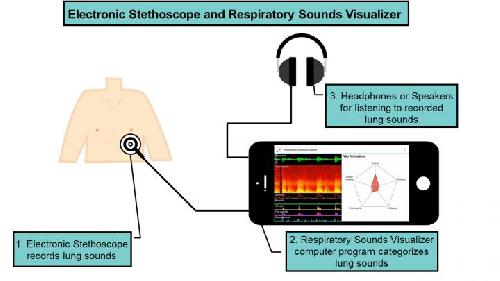The classic stethoscope has entered the digital age. Medical researchers have created a computer program that connects to an electronic stethoscope to classify lung sounds into five common diagnostic categories.
The Respiratory Sounds Visualizer computer program and the new electronic stethoscope with a high sensitivity for lung sounds were developed by a team of three physician researchers at Hiroshima University and Fukushima Medical University, in collaboration with the industrial company Pioneer Corporation (Head Office: Kawasaki-shi, Kanagawa; President: Susumu Kotani).
Recorded lung sounds of 878 patients were classified by respiratory specialist doctors. The researchers then turned these diagnoses into templates to create a mathematical formula that evaluates the length, frequency, and intensity of lung sounds. The computer program can recognize the sound patterns consistent with different respiratory diagnoses.
 1. Electronic stethoscope records patient's breathing.2. Lung sounds are sent to the phone or tablet and analyzed by the computer program.3. Medical professionals can listen and see the results in real time from any location to diagnose the patient. Credit: Hiroshima University.
1. Electronic stethoscope records patient's breathing.2. Lung sounds are sent to the phone or tablet and analyzed by the computer program.3. Medical professionals can listen and see the results in real time from any location to diagnose the patient. Credit: Hiroshima University.
The program analyzes the lung sounds and maps them on a five-sided chart. Each of the five axes represents one of the five types of lung sounds. Doctors and patients can quickly look at the chart and see that when more of the length of the axis is covered in red, that diagnosis is more likely.
Medical professionals listening to heart and lung sounds on a stethoscope need to overcome any background noise and recognize if a patient has one or multiple irregularities.
Any doctor working in less-than-ideal circumstances, from a busy emergency room to a field hospital, could rely on the computer program to "hear" what they might otherwise miss. The computer program's ability to recognize when a patient has multiple lung problems at the same time will benefit student doctors as they develop their own expertise.
The results from the computer program are simple to interpret and can be saved and shared electronically. In the future, this convenience may allow patients to track and record their own lung function during chronic conditions, like chronic obstructive pulmonary disease (COPD) or cystic fibrosis.
The Respiratory Sounds Visualizer will soon be publically accessible. Dr. Shinichiro Ohshimo, MD, PhD, is one of the researchers involved in developing the technology and works with patients in the Department of Emergency and Critical Care Medicine at Hiroshima University Hospital.
"We plan to use the electronic stethoscope and Respiratory Sounds Visualizer with our own patients after further improving [the mathematical calculations]. We will also release the computer program as a downloadable application to the public in the near future," said Dr. Ohshimo.
source: Hiroshima University